MINI-LINK BAS 5-26
Technical Description EN/LZB 111 0542 P2B
Depending on the type of permits, traffic cells or minislots are
inserted. Minislots contain the requests to transmit contract based on
traffic and buffer filling level.
Then ATM traffic is first scrambled, FEC encoded and modulated. On
the RN side the received stream is demodulated and checked for
header errors, corrupted cells are discarded.
After the FEC decoding an EBER function is provided to detect if the
bit errors exceed a certain threshold, that is if the radio link quality
from the NU is unacceptable.
Then CRC over the whole ATM cell, including the payload is checked
and used for fault handling and performance monitoring. In case a
MAC control cell with requests is received, the request information,
after error checking, is sent to the MAC function.
The demultiplexer distinguishes between the ATM traffic cells and the
RC control cells passing the ATM traffic cells on to the cellmux port
and to the backplane interface.
The RC is using ATM cells in uplink direction, as well as in
downlink. When these upstream cells, which have a specific VPI/VCI
value, arrive to the deframer, they are routed to a port, which is
connected to the modem.
To identify from which terminal a slot is coming and what kind of
data it contains, the RC uses information on terminal address and slot
content from the MAC function.
5.6.3 RC Cells Insertion
The RC is an internal channel for AT-node communication. VC
connections are dedicated to this purpose.
The frame format of the RC packets is depicted in Figure 5-14. A field
address is foreseen in order to address the relevant terminal.
6 bits
2 bits
4 bytes
Address Dummy Data
Figure 5-14 RC Frame Format
Radio Control channel (RC) packets are mapped into ATM cells as
depicted in Figure 5-15. Field address is mapped in the VPI field that
uniquely identifies the addressed terminal. A specific VCI value has
been adopted for these cells.

